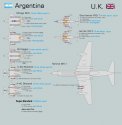Sea Harriers with three 1000 lbs bombs
I have take a look for see the Sea Harriers CAP range i find CVBG stationed to 60 mn ot Pt Stanley, 110 km maybe up to 150 km without AEW.
A-4 can' t attack to these distances so far only up over Falklands Ilands so CVBG can't be attacked by 50 % of the Argentinans fighter-bombers considering Pucara is not a jet less capable other category.
And also to be more secure and " rebuild " CVBG stationed in general to 200 mn limit of the TEZ
But i don' t find CVBG locations during San Carlos landing the most important moment, 60 mn ? seems not S-E but South ?
If someone can say me please or better a map with location ? i love map for it
Some points interesting for understand the tactic :
Saturday 1 May:
00:00:00: The CVBG (Carrier Battle Group) sails towards the Falklands and takes up position 70nm to the south east of Stanley. HMS Brilliant and HMS Broadsword stays close in with the carriers. Near them is a screen of RFAs, further out is four frigates and, twenty miles up-threat, three Type 42s as a picket line. Four Sea Harriers provide a continuous CAP (Combat Air Patrol) cover for the CVBG and Sea Kings search for enemy submarines.
Saturday 8 May:
00:00:00: The TEZ is widened from 200nm around the Falklands to within 12nm of Argentina's coast. The CVBG sails to a new patrol area 60nm due east of Stanley
Friday 14 May:
00:00:00: The CVBG takes up a new position 60nm to the north east of Stanley
Monday 17 May:
00:00:00: Today is Argentina's Navy Day and major offensive actions are expected. The CVBG moves south to a new patrol station 60nm south east of Stanley
Tuesday 18 May:
On Tuesday 18 May the Amphibious Task Group joins up with the carriers 200nm north east of the Falklands
Tuesday 25 May:
00:00:00: Today is the Argentine National Day, and fierce attacks are expected. The CVBG starts moving to within 60nm of the islands to cover Atlantic Conveyor's passage to San Carlos the coming night and allowing Sea Harriers to stay longer on CAP (Combat Air Patrol) over the beachhead.
Wednesday 26 May
00:00:00: The CVBG withdraws to its original station 200nm north of the Falklands Islands.
I have take a look for see the Sea Harriers CAP range i find CVBG stationed to 60 mn ot Pt Stanley, 110 km maybe up to 150 km without AEW.
A-4 can' t attack to these distances so far only up over Falklands Ilands so CVBG can't be attacked by 50 % of the Argentinans fighter-bombers considering Pucara is not a jet less capable other category.
And also to be more secure and " rebuild " CVBG stationed in general to 200 mn limit of the TEZ
But i don' t find CVBG locations during San Carlos landing the most important moment, 60 mn ? seems not S-E but South ?
If someone can say me please or better a map with location ? i love map for it
Some points interesting for understand the tactic :
Saturday 1 May:
00:00:00: The CVBG (Carrier Battle Group) sails towards the Falklands and takes up position 70nm to the south east of Stanley. HMS Brilliant and HMS Broadsword stays close in with the carriers. Near them is a screen of RFAs, further out is four frigates and, twenty miles up-threat, three Type 42s as a picket line. Four Sea Harriers provide a continuous CAP (Combat Air Patrol) cover for the CVBG and Sea Kings search for enemy submarines.
Saturday 8 May:
00:00:00: The TEZ is widened from 200nm around the Falklands to within 12nm of Argentina's coast. The CVBG sails to a new patrol area 60nm due east of Stanley
Friday 14 May:
00:00:00: The CVBG takes up a new position 60nm to the north east of Stanley
Monday 17 May:
00:00:00: Today is Argentina's Navy Day and major offensive actions are expected. The CVBG moves south to a new patrol station 60nm south east of Stanley
Tuesday 18 May:
On Tuesday 18 May the Amphibious Task Group joins up with the carriers 200nm north east of the Falklands
Tuesday 25 May:
00:00:00: Today is the Argentine National Day, and fierce attacks are expected. The CVBG starts moving to within 60nm of the islands to cover Atlantic Conveyor's passage to San Carlos the coming night and allowing Sea Harriers to stay longer on CAP (Combat Air Patrol) over the beachhead.
Wednesday 26 May
00:00:00: The CVBG withdraws to its original station 200nm north of the Falklands Islands.



